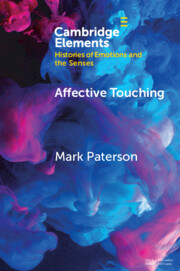Refine search
Actions for selected content:
29 results
Chapter 5 - The Bookish Sensorium
-
- Book:
- How the World Became a Book in Shakespeare's England
- Published online:
- 09 August 2025
- Print publication:
- 14 August 2025, pp 160-190
-
- Chapter
- Export citation
Cultivating Desire: Touch and Transgressive Thrill in the Art Fair
-
- Journal:
- Advances in Archaeological Practice / Volume 13 / Issue 1 / February 2025
- Published online by Cambridge University Press:
- 22 May 2025, pp. 31-44
-
- Article
-
- You have access
- Open access
- HTML
- Export citation

Affective Touching
- Neurobiology and Technological Applications
-
- Published online:
- 20 February 2025
- Print publication:
- 20 February 2025
-
- Element
- Export citation
Chapter 4 - Aesthetic Agents
-
- Book:
- Guru Nanak's Transcendent Aesthetics
- Published online:
- 21 November 2024
- Print publication:
- 21 November 2024, pp 161-204
-
- Chapter
- Export citation
A multimodal approach to polysemy: the senses of touch
-
- Journal:
- Language and Cognition / Volume 16 / Issue 4 / December 2024
- Published online by Cambridge University Press:
- 23 April 2024, pp. 1697-1717
-
- Article
-
- You have access
- Open access
- HTML
- Export citation
Coda
-
- Book:
- Alone with Others
- Published online:
- 26 October 2023
- Print publication:
- 09 November 2023, pp 118-119
-
- Chapter
- Export citation
Chapter 1 - Tact’s History
-
- Book:
- Alone with Others
- Published online:
- 26 October 2023
- Print publication:
- 09 November 2023, pp 16-36
-
- Chapter
- Export citation
Chapter 4 - Individuation (Truffaut)
-
- Book:
- Alone with Others
- Published online:
- 26 October 2023
- Print publication:
- 09 November 2023, pp 83-100
-
- Chapter
- Export citation
10 - Enhancing Relationships Through Positive Interpersonal Processes
- from Part III - Relationship Maintenance
-
- Book:
- The Science of Romantic Relationships
- Published online:
- 17 August 2023
- Print publication:
- 31 August 2023, pp 343-377
-
- Chapter
- Export citation
Chapter 6 - Substitution
-
- Book:
- Phenomenology of the Icon
- Published online:
- 17 August 2023
- Print publication:
- 31 August 2023, pp 188-216
-
- Chapter
- Export citation
Crowded Choreographies: From Assembly to Association and Back Again
-
- Journal:
- Dance Research Journal / Volume 55 / Issue 2 / August 2023
- Published online by Cambridge University Press:
- 17 August 2023, pp. 6-27
- Print publication:
- August 2023
-
- Article
-
- You have access
- Open access
- HTML
- Export citation
3 - The Erotics of Again: Time and Touch in Sappho
- from Part I - Bodies
-
- Book:
- Greek Poetry in the Age of Ephemerality
- Published online:
- 02 June 2023
- Print publication:
- 27 April 2023, pp 97-132
-
- Chapter
- Export citation
1 - The Making Sense
- from Part I - The Making Sense
-
- Book:
- The Making Sense of Politics, Media, and Law
- Published online:
- 06 April 2023
- Print publication:
- 13 April 2023, pp 3-22
-
- Chapter
-
- You have access
- Open access
- HTML
- Export citation
8 - Connecting with Children and Young People
- from Part 2 - Strengthening Relationships with Children and Young People and Giving Support
-
- Book:
- A Guide to the Mental Health of Children and Young People
- Published online:
- 27 October 2022
- Print publication:
- 03 November 2022, pp 166-172
-
- Chapter
- Export citation
Chapter 11 - The Vibrissa Sensorimotor System of Rodents: A View from the Sensory Thalamus
- from Section 5: - Sensory Processing
-
-
- Book:
- The Thalamus
- Published online:
- 12 August 2022
- Print publication:
- 01 September 2022, pp 214-220
-
- Chapter
- Export citation
4 - Embodiment
- from Part I - Talk as Social Action
-
-
- Book:
- Talking with Children
- Published online:
- 16 June 2022
- Print publication:
- 30 June 2022, pp 78-96
-
- Chapter
- Export citation
Chapter 4 - Touch: Transmission, Contact, Connection
-
- Book:
- Music and the Queer Body in English Literature at the Fin de Siècle
- Published online:
- 15 April 2022
- Print publication:
- 14 April 2022, pp 138-174
-
- Chapter
-
- You have access
- Open access
- HTML
- Export citation
Caregiver–child proximity as a dimension of early experience
-
- Journal:
- Development and Psychopathology / Volume 34 / Issue 2 / May 2022
- Published online by Cambridge University Press:
- 25 January 2022, pp. 647-665
-
- Article
-
- You have access
- Open access
- HTML
- Export citation
6 - On the Wards
-
- Book:
- Contact Zones of the First World War
- Published online:
- 17 August 2021
- Print publication:
- 26 August 2021, pp 153-176
-
- Chapter
- Export citation
Chapter 5 - Physic and Metaphysics
- from Part II - Professionalisation
-
-
- Book:
- Literature and Medicine
- Published online:
- 04 June 2021
- Print publication:
- 24 June 2021, pp 97-118
-
- Chapter
- Export citation
